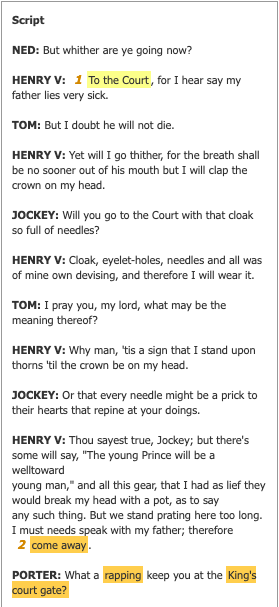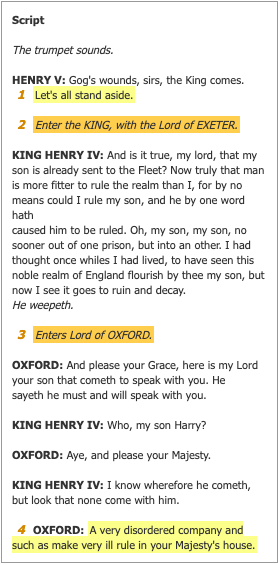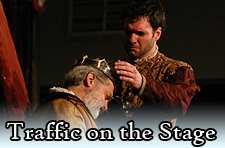Famous Victories: To the Court
Introduction
In this case study you will be taken through the process through which the company developed the blocking for a particularly tricky section of text from Famous Victories where the young prince and his companions visit his father at court. In this section of text, characters’ entrances and exits are not clearly marked and the company had to decide how the sequence of action could effectively be performed on our simple stage structure.
Instructions
Read the Scene
Print out the pdf and read through the text, highlighting any moments where you think the text implies movement on the stage: you might find clues in the stage directions, within the dialogue or from the sudden appearance of characters not mentioned in the scene before. Make notes about what you think is happening and where you think the action is taking place. Once you have finished analyzing the text proceed to the next tab to check your results against the SQM company’s decision-making process.
At the Gate
What did you highlight in the script? Check your results against the SQM company’s decision-making process.

1. To the Court
Previous to this moment in the scene there has been no clear indication of where the action is taking place, but this gives us a future destination for the scene.2. Come away, Rapping and the King’s Court Gate
Given our previous clue about their destination we must presume that the Prince is saying “come away” to the court. The next line is spoken by a new character the Porter who refers to the “king’s gate” and that somebody has been “rapping” on it.
No stage direction is given for the arrival of the porter or for the movement of the Prince and his companions but the internal evidence of the dialogue tells us that they have arrived at court and have knocked on the king’s gate.
Conclusions: Answering the Textual Riddle
How was this performed? What we have here is a textual riddle that needs to be unraveled before we can stage the scene.
What do we know?
- The prince is travelling to the court.
- A porter speaks on stage.
- Someone has knocked on the king’s gate.
As a general principal in our production we looked for the simplest, effective way to perform the text while staying true to the majority of the stage directions.
The Arrival of the King
The next section of text is full of clues about the location of the scene and the traffic on the stage.

1. Let’s all stand aside.
Here is another directive for stage movement from within the dialogue but what does it mean? Where is “aside”? Standing aside is a relatively common directive in Elizabethan drama and usually means that characters retreat to one side of the stage in order to overhear the conversation of the new characters arriving. No exit is marked for the prince and his companions so perhaps this is what happens here. But then no exit is marked for the Porter and since he does not appear in the rest of the scene it would be odd if he remains on stage at this point. We need more evidence here before we can make a decision about the stage traffic, but the most likely interpretation at this point is that the prince and his companions remain on-stage but are not noticed by the arriving king.
2. Enter the KING, with the Lord of EXETER.
This is a nice clear stage direction but the subsequent dialogue does not establish where the king is entering from or to. We might presume he is now also outside the castle gates but this seems a strange place for him to come and share his personal laments about the behavior of his wayward son.
3. Enters Lord of OXFORD.
OXFORD: And please your Grace, here is my Lord your son that cometh to speak with you. He sayeth he must and will speak with you.
Now this is odd. Oxford’s entrance is marked clearly enough but then he announces that the prince has arrived to see the king. The stage direction marking his entrance implies he is coming on stage from the tiring house but he is bringing a request from the prince who, according to the stage directions, has not yet left the stage.
4. OXFORD: A very disordered company and such as make very ill rule in your Majesty’s house.
Oxford tells the king that the prince’s companions are making a nuisance of themselves in the court. If this is the case, then surely they cannot be on stage since their noise would be entirely distracting for the audience. It would now appear that they did leave the stage after all when the prince decided to “stand aside”.
Decide Which Characters Can be Doubled
The person in charge of the doubling needs to establish all the possible doubling options before making decisions. The first rule is that actors cannot play characters that appear in consecutive scenes because they need time to exit, change their costume and re-enter. But if there is one French scene between their exit and subsequent re-entrance, doubling may be possible.
The section of text you have analyzed could be performed by 7 actors even though there are 9 characters. Take a look at the chart and consider which characters could be doubled.
Complete a Doubling Chart for the Entire Play
Since there are 18 lines between the exit of the two receivers and the entrance of John Cobbler and friends then it would be possible to double the receivers with John, Robin or Lawrence. Before we could be sure this would work we would have to complete the doubling chart for the entire play to make sure these characters do not appear in later scenes together or in consecutive scenes.
If you follow the line for the receivers you will see that they do not appear again in the play. The doubling we have discovered is a genuine doubling option because the receivers do not appear on stage simultaneously with John Cobbler and his friends or in consecutive French scenes, but should they be doubled? To make a doubling decision we need to establish all the options and consider important conditional factors.

